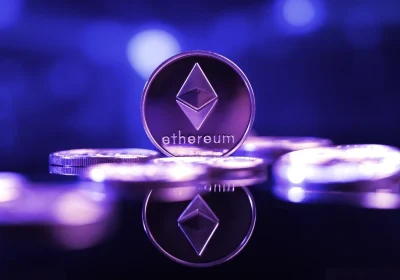What Is Ethereum? Simple Guide for Beginners

Ethereum (ETH) is a decentralized network for executing and verifying transactions that use lines of code called smart contracts. Smart contracts on Ethereum allow users to define and settle transactions without the need for a third party. Despite that, Ethereum is the second-largest block in the world still not everyone knows how the Ethereum block operate.
What is Ethereum (ETH)?
Ethereum is a decentralized blockchain network that securely executes and verifies transactions using lines of code referred to as smart contracts. These smart contracts allow participants to transact with each other without a third party involved.
Read Also: What is Bitcoin? A Simple quick Guide for Beginners
History of ETH.
The whole idea behind Ethereum was initially started in 2013 by a Canadian programmer called Vitalik Buterin. Hence, he is often referred to as the main founder of Ethereum. Other co-founders of the project include Gavin Wood, Charles Hoskinson, Anthony Di Iorio, and Joseph Lubin.
At an early age, Buterin Vitalik was already venturing into Bitcoin He was among the Early supporter of Bitcoin.
Although, at the younger age of 17 in 2011, Buterin began to imagine a platform that went beyond Bitcoin’s financial use cases and he launched a whitepaper in ETH 2013 describing what would eventually become Ethereum.
In 2014, Buterin and the other co-founders of ETH released a campaign to gain traction. They sold about 60,000,000 ETH tokens to investors through an initial coin offering (ICO), raising 31,000 BTC (app. $18.3 million at the time).
The Ethereum Frontier network was launched in 2015. Not too long after that, developers started to write smart contracts and develop decentralized apps on the network. Miners also began joining the Ethereum network to help secure the blockchain and earn ETH from mining blocks.
Ethereum (ETH) Price History
Ethereum is one of the most successful cryptocurrencies in the market. Since its launch, the project has gained tremendous value, recognition, and adoption.
When Ethereum was launched it was less than a dollar but now is trading around $3000, and this same ETH has reached its all-time high of $4,878 around Nov 10, 2021.
What Makes Ethereum Different?
Ethereum is a decentralized blockchain platform that enables peer-to-peer transactions. While this is akin to other cryptocurrency projects, Ethereum has other features that make it unique.
Unlike Bitcoin, which has limited use cases, the Ethereum blockchain was built to support other decentralized applications (dApps). In other ways, developers can create and run dApps on the network.
More also, Ethereum was the firm initiator of the smart contract sector.
Ethereum Operation
Knowing the technology behind the Ethereum network will aid us to answer the question: How does this operate? Ethereum’s functionality is driven by its use of smart contracts, consensus mechanisms, and the Ethereum Virtual Machine (EVM), amid other general features common among cryptocurrencies.
Smart Contracts
Smart contracts are lines of code that are stored on the blockchain. They are created to be implemented automatically when fixed terms and conditions are met.
The native programming language of Ethereum is called Solidity. Solidity is similar to other programming languages like C++, JavaScript, Python, etc.
Each user can relate to the smart contract by submitting transactions that carry out functions established on the smart contract. This means that two people can have a transaction together without the middle man and none of their transactions can be deleted.
Consensus Mechanism
Consensus on a blockchain is achieved when all the nodes on the network agree on a single data. It has to do with the validation of transactions. Ethereum currently uses a consensus mechanism similar to that of Bitcoin called Proof-of-Work (PoW).
How does PoW operate? When a miner in the network solves a hash problem, it gets rewarded with some amount of ETH and wins the right to add the next block to the blockchain.
This process gets repeated around every 12 seconds on the Ethereum network. PoW usually consumes a lot of energy compared to other consensus mechanisms.
Ethereum Virtual Machine (EVM)
The Ethereum Virtual Machine (EVM) is a computational system that developers utilize in creating decentralized applications (dApps) on the Ethereum network. Developers achieve this by writing smart contracts using Solidity.
The solidity code is then converted into low-stage machine instructions, commonly referred to as opcodes which are understood and executed by the EVM, Ethereum stores all account data and smart contracts.
EVM is one of Ethereum’s most coveted features as it allows developers to easily launch applications across other compatible networks. Examples of EVM compatible networks include Polygon, Avalanche, BNBChain, etc.
Read Also: Cryptocurrency UPSC, crypto definition, advantages, and disadvantages.
Ethereum Use Cases
Bitcoin was created to serve as a form of digital cash, enabling people to send money anywhere around the world. Ethereum was created to serve more purposes than that. Here are the major use cases for Ethereum.
Decentralized Autonomous Organizations (DAOs)
A decentralized autonomous organization is a community-driven system with no central authority. DAOs can be likened to traditional organizations that are managed by boards, committees, and executives. The difference though is that DAOs are not overseen by a limited group. So how does it run?
DAOs are regulated singly by individual members who collectively make decisions about the future and progress of the project. This is possible because DAOs use smart contracts to define and enforce
the rules of the organization.
To gain membership into a DAO, a user needs to buy the project’s cryptocurrency and hold it. Holding the asset grants users membership and also gives them the power to join other members of the DAO in any form of voting or decision-making regarding the organization, according to the amount of the asset they hold. This system enables everyone in the organization to contribute.
It is noteworthy that many DAOs run on the Ethereum blockchain. The first decentralized organization, driven by ether, was dubbed The DAO. It enabled users to send money from anywhere anonymously and then the owners were rewarded with tokens, granting them voting rights in the organization. The DAO ultimately failed following an early and controversial hack incident in 2016.
Despite the failure of the earliest DAO experiment, the idea of DAOs is very much alive. Most decentralized protocols such as Compound, Aave, and BitDAO implement a DAO model to allow token holders to govern key improvement decisions.
Token Sale
The Ethereum network supports crowdfunded token sales, previously conducted using an initial coin offering (ICO) model. Today, token sale events have different names including Initial decentralized offering (IDO) and initial farm offering (IFO).
New blockchain projects conduct token sales to generate capital for development and growth. Users who love to partake in the project can often choose to involve in the fundraising event by sending coins to a designated address in exchange for the newly launched token. The token may have some use cases relating to the service rendered by the project, which the investor gets to benefit from. Or it may serve as involvement in the project.
A major disadvantage of decentralized token sales is that most of them are usually unregulated. For that reason, investors need to diligently research before crowdfunding a project. While some token sales have yielded huge returns for investors, many others have led to significant losses.
Decentralized Finance (DeFi)
Decentralized Finance (DeFi) is an ecosystem of financial applications built on blockchain technology.
DeFi protocols are built on the public blockchain, with Ethereum being a primary network for hosting them. Since these platforms are decentralized, they are managed by a community of users.
DeFi allows users to perform various financial activities such as earning interest, borrowing, lending, buying, insurance, trading derivatives, and many more. This makes DeFi better than traditional banks as it allows users to access its service without any paperwork or third party, while still being pseudonymous.
Non-Fungible Tokens (NFTs)
A non-fungible token (NFT) is a digital asset that is not directly exchangeable for another. They are often designed as collections, with each token possessing unique features that make them distinct from others. Ownership of an NFT is validated only on the blockchain, NFTs can be utilized in many ways which include the verification of the authenticity of art, academic and medical files, etc. it can also be used for music, gaming, and even tweets.
NFTs can be created on Ethereum or on other blockchains that support this functionality. Examples of leading NFTs today include CryptoPunks, Bored Ape Yacht Club (BAYC), and Mutant Ape Yacht Club (MAYC). These top three NFTs run on the Ethereum blockchain.
GameFi
GameFi is simply a combination of the words “game” and “finance.”
GameFi was created as a means for game players to earn cryptocurrencies while gaming. This is possible because such games are built on the blockchain. With this incentive, players are motivated to progress to higher levels in the games they play.
GameFi platforms can choose to set various instructions that must be met by players to allow them to play or qualify to get the reward. While on the other hand, some platforms allow their players to earn rewards directly from the games they play, others may require gamers to invest a small amount to gain access to the game and its rewards.
Gamers can earn rewards such as cryptocurrencies and NFTs like virtual land and yachts. Users can rent out these items to generate more revenue.
A popular blockchain-based gaming project is Axie Infinity, which was originally built on the Ethereum network but later migrated to the Ronin Network, an Ethereum-linked sidechain.
Advantages of Ethereum
The Ethereum network has seen increased adoption of the following advantages:
Permissioned networks
The Ethereum network was developed in a way that permits the existence of public and private networks. A permissioned network is not publicly accessible by users unless they are granted access by the ledger administrators. With this feature, various corporate organizations can utilize the permissioned network to carry out their businesses.
Tokenization
Any asset that has been registered in a digital form can be tokenized on Ethereum. One of the most popularly used Ethereum token standards is ERC-20. Instead of running on their blockchains, ERC-20 tokens run on the Ethereum blockchain. There are also other token standards on the network, such as the ERC-721 which supports the creation of non-fungible assets.
Decentralization
The decentralized nature of Ethereum enables the distribution of knowledge and trust among users in the network while eliminating the need for a central authority to moderate transactions.
Liquidity
The term liquidity is used to describe the ease of exchange between two assets. At this time, ETH is highly liquid as it can easily be converted to fiat and other cryptocurrencies. ETH market capitalization is close to the same as popular financial institutions such as Bank of America and Mastercard.
Interoperability
Interoperability in blockchain refers to the means through which various blockchains share information and communicate with each other, granting access to their data. At this time, several cross-chain bridges support the Ethereum blockchain. With these bridges, Ethereum users can migrate ERC-20 tokens to other networks such as Solana, BNBChain, Polygon, Terra, etc.
Disadvantages of Ethereum
The Ethereum network currently faces several limitations. The most prominent ones include:
Ethereum’s Programming Language
Solidity, as mentioned earlier, is the native programming language of Ethereum. It is difficult though to find courses in Solidity that can be learned by individuals with little or no prior knowledge of the subject. This brings about a limitation to the growth of the network.
At the same time, it is worth mentioning that Ethereum’s Solidity is gradually becoming popular. Hence, this limitation is likely one that will go away as the network gains traction.
Issues With Scalability
Scalability has to do with the ability of the Ethereum mainnet to handle a growing number of transactions in the blockchain network. At this time, the Ethereum network can only handle 12-15 transactions per second. Hence, the network is slower and more expensive with increased usage.
Bitcoin was created to serve as a digital payment system. Ethereum, on the other hand, was created to serve diverse purposes, such as having a ledger, smart contracts, and so on, all of which may lead to errors, malfunctions, and even hacks.
There have been cases where hackers exploited bugs on Ethereum, which by extension affects other projects that run on the network.
High Network Fees

Due to scalability issues, an overload of transactions can lead to ridiculously high gas fees that make the network inaccessible to the average user.
During such peak hours, a single Ethereum transaction could cost as much as $1,000, a high figure compared to major competitors such as Solana ($0.005), BNBChain ($0.3), and Polygon ($0.01).
What is ETH 2.0?
Since the launch of Ethereum in 2015, there has been a need to make improvements to some features of the network. To improve the network, Ethereum 2.0 was introduced.
Ethereum 2.0, dubbed Eth2 or Serenity, is an upgrade that will improve the performance of the Ethereum blockchain. Eth2 will resolve the issue of scalability and high gas fees, making the network faster, cheaper, and more efficient.
Read Also: What is Seed Phrase and How to Use It Securely
While Ethereum 1.0 uses a PoW consensus mechanism, Ethereum 2.0 will introduce Proof-of-Stake (PoS) to the network.
The proof-of-stake is a consensus mechanism that permits fast and cheaper transactions. Ethereum developers argue that PoS is better than PoW in its functionality, although this is not entirely proven.
In PoS, there are validators responsible for the addition of new blocks, just the way PoW has miners. Validators are selected at random to create or validate blocks. To become a validator, a user needs to stake 32ETH using a self-staking method or stake any amount of their choice using a liquid staking solution.
Some key benefits of PoS include its low consumption of energy to validate blocks, its speed in processing more transactions, and the availability of more nodes in the system, as hardware requirement is not as heavy as it was for PoW.
It is important to know that Eth2 will not be issued as a new coin, rather it will simply be an upgrade to the existing Ethereum. It also won’t change the amount of ETH being held by its users, but part of the transaction fees will be burned to help reduce the circulating supply of the cryptocurrency.
The Eth2 upgrade is now referred to as the consensus layer of Ethereum, while Eth1 is the executive layer of the blockchain. This would greatly reduce the confusion among new users of Ethereum. It will also reduce the risk of fraudulent acts of people who might claim that Ethereum needs to be converted to an “Eth2 token” and thereby steal funds from unsuspecting users.
How to Stake ETH
Cryptocurrency staking often involves a holder delegating that designated amount of coins to help support the blockchain network and validate transactions. The user is then rewarded with some amount of crypto from the annual percentage rate (APR), according to the amount staked and the duration it was staked.
Exchange Staking
This refers to staking on any centralized exchange (CEX).
CEX is a trading platform that serves as a third party between users and their crypto funds. It enables users to buy, sell and hold their cryptocurrency funds.
An advantage of CEXs is that cryptocurrency wallets can be retrieved if lost, giving the user access to their lost funds. This is something that is not possible with non-custodial wallets.
There are many centralized exchanges today. These include Binance, Coinbase, Kraken, etc.
While Ethereum can be staked on these platforms, it has some limitations. Ethereum 2.0 is still underway to be fully released. Until the initial phase of Eth 2.0 is released, staked Ethereum cannot be unstacked.
Solo Staking
The Ethereum Foundation describes solo staking as “the gold standard for staking” on Ethereum. This method of ETH staking requires the user to become a validator by staking a minimum of 32 ETH and then taking care of the responsibilities of validations, which are generating and approving new blocks in the system.
Although, investors will need to stake their ETH until the initial phases of ETH 2.0 have finished. This implies that the stake can not be released until that time, which is currently unknown. Therefore, this method of staking is beneficial majorly for long-term investors who don’t mind their funds being locked for a significant period.
The minimum amount to be staked ( 32 ETH) is also a scare for investors who do not have that amount of money to partake in being a validator.
Liquid Staking
Liquid staking is a process through which users get to stake an Ethereum amount of their choice and unstake whenever they choose to.
This is achieved when investors receive a tokenized form of the staked ETH. The tokens can function like actual ETH, as they can be sent wherever the user wants, while still keeping the liquidity active and receiving rewards.
A good example of a liquid staking solution is Lido Finance
Differences between Ethereum and Bitcoin
Ethereum blockchain was developed to serve as a smart contract platform to host decentralized applications while the Bitcoin protocol was designed to function as a peer-to-peer electronic cash system.
Additionally, although Ethereum currently uses a PoW consensus mechanism, the network plans to migrate to a PoS. As reported in April, lead Ethereum developer Tim Beiko said the smart contract platform is in its final chapter of PoW.
How to Buy ETH
Interested investors can purchase ETH like any other cryptocurrency from trading platforms such as Coinbase, Kraken, and Binance. To buy Ether, you will need to create and verify an account with the exchange.
Sure Steps to buying Ethereum on Binance
Step 1: Create a Binance account
Step 2: Verify your Binance account
Step 3: Buy Ethereum
Deposit Fiat Currency
You can deposit fiat into your Binance account through bank transfer or card (credit or debit). However, this option is not available to everyone. After funding your account, you can purchase the amount you want, according to your available balance.
Using Peer-to-Peer (P2P)
In countries and regions where banks are banned from directly serving crypto entities, investors can convert their fiat to crypto through peer-to-peer platforms. This method involves buying ETH from other crypto traders on Binance while you transfer the funds to them through a bank or other available methods.
Some questions still come frequently from people around the world which may include:
How many ETH coins are there?
According to Etherscan, 118.7 billion ETH have been issued and are currently in circulation.
Ethereum has been tagged as a cryptocurrency with an unlimited supply. This is different from Bitcoin, which has a fixed amount of supply of 21 million BTC. Every four years, the Bitcoin supply gets halved, with the next halving scheduled for 2024. While Ethereum does not have such a feature, ETH supply is expected to decline as the network moves to a PoS mechanism.
Who owns the most Ether?
The company with the highest amount of ether is Grayscale Ethereum Trust with about 2.5 million ETH (worth $8.2 billion) in its portfolio.
Next on the list is Binance, the world’s largest crypto exchange. The company holds 1.9 million ETH worth about $6.4 billion.
When will Ethereum move to Proof-of-Stake?
Ethereum will likely move to Proof-of-Stake by the end of this year. The Ethereum Merge was initially scheduled to take place in June 2022 but was later postponed until this year to give room for more tests.
What is Ethereum Layer 2?
Ethereum layer 2 solutions attempt to solve the network’s scalability issue. Often a separate blockchain strongly linked to Ethereum layer 1, a typical layer 2 blockchain are designed in such a way that it regularly communicates with Ethereum and shares its workload.
Ethereum layer 1 takes care of the security, decentralization, and network data, while layer 2 takes care of the system’s scalability.
Read Also: How to buy cryptocurrency
Can Ethereum overtake Bitcoin?
Ethereum cannot overtake Bitcoin in the short term. However, there is the potential to do so in the long term.
Can I get rich with Ethereum?
The cryptocurrency market promises a lot of wealth, so it is possible to become rich by investing in Ethereum or any other good cryptocurrency project. Those who invested in Ethereum in 2015 and held their position to date are undoubtedly wealthy today. It is very sure to be rich if you invest wisely.

Cryptolifedigital is a cryptocurrency blogger and analyst known for providing insightful analysis and commentary on the ever-changing digital currency landscape. With a keen eye for market trends and a deep understanding of blockchain technology, Cryptolifedigital helps readers navigate the complexities of the crypto world, making informed investment decisions. Whether you’re a seasoned investor or just starting out, Cryptolifedigital’s analysis offers valuable insights into the world of cryptocurrency.










